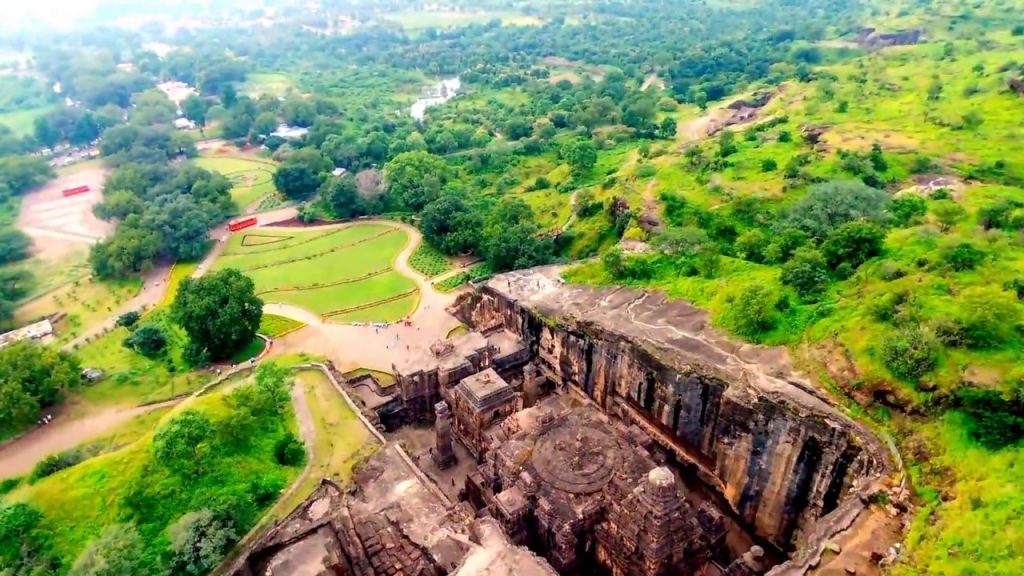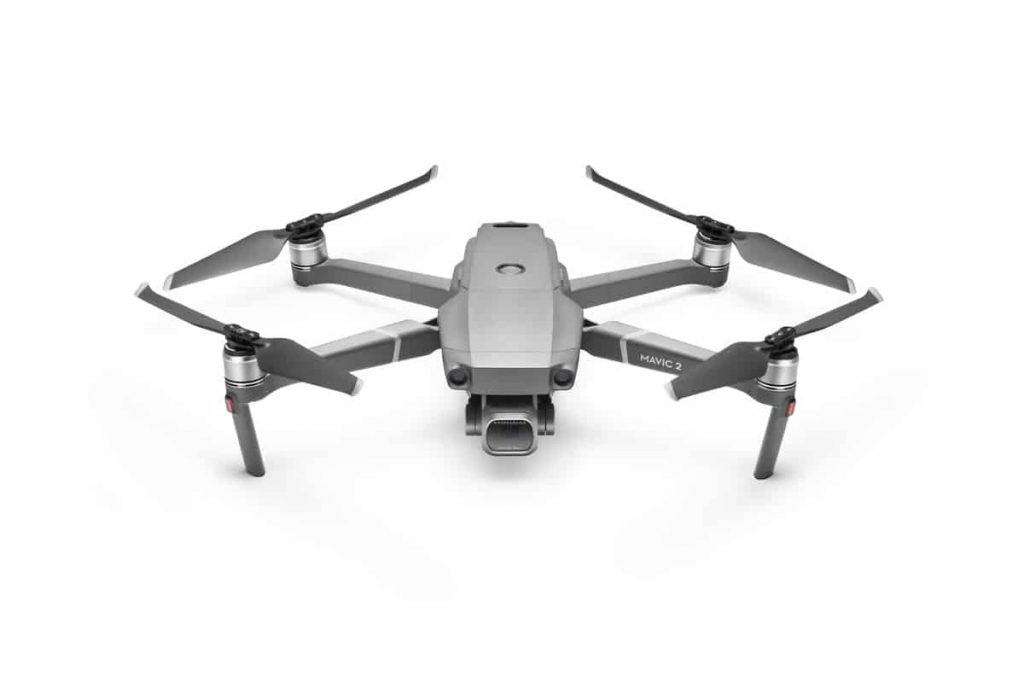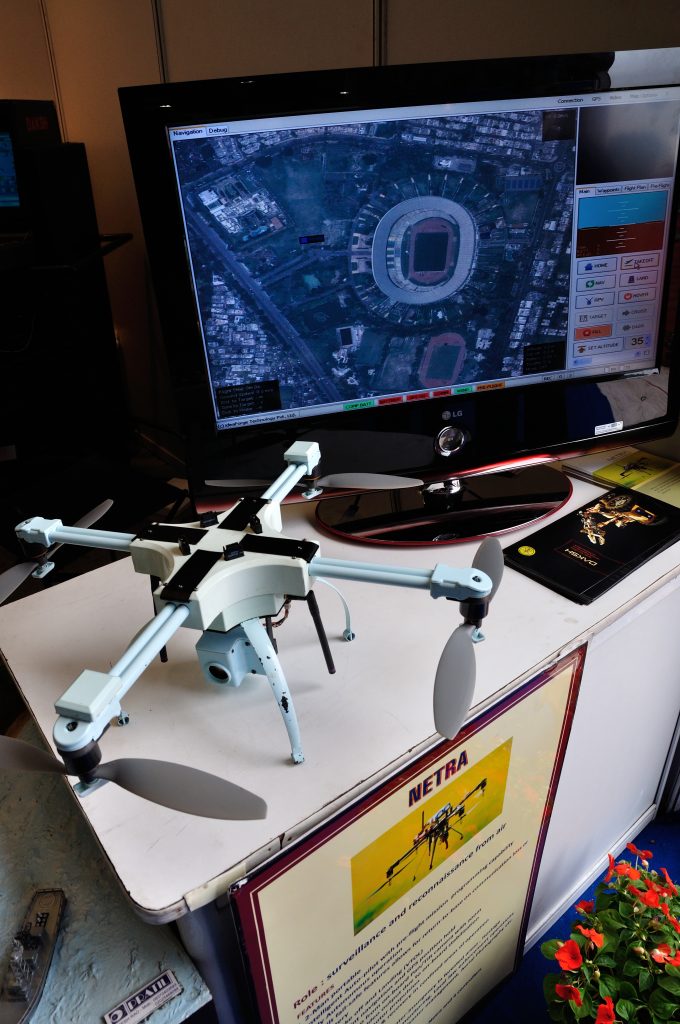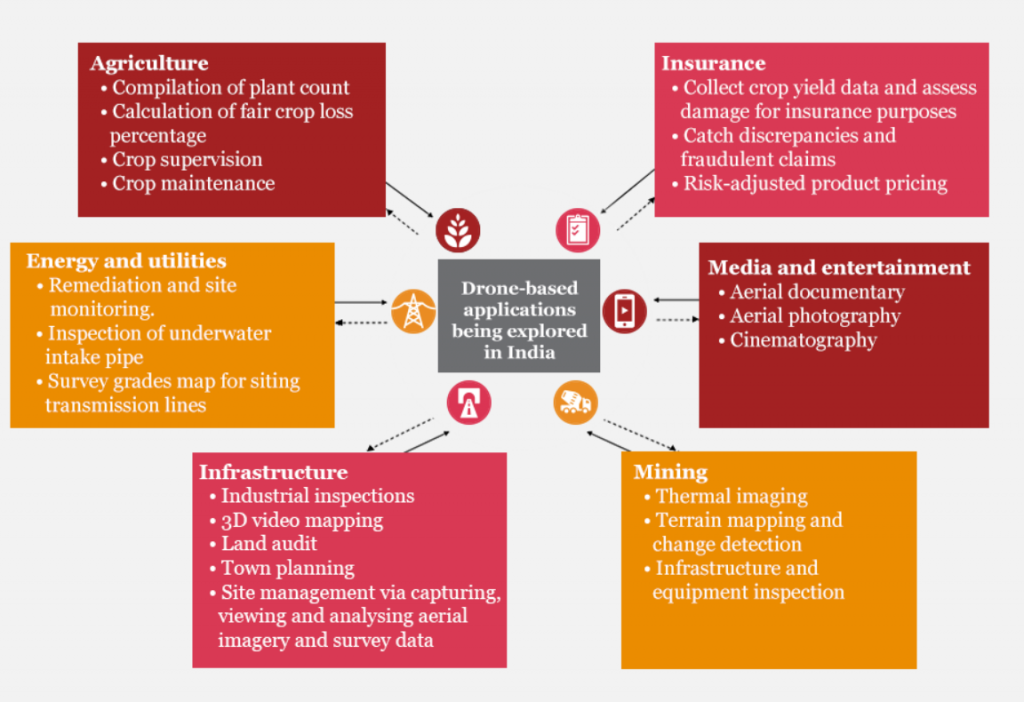Contents
- NTPC allowed to use drones for research and inspection of Thermal Power Projects.
- India Meteorological Department Commissions Flash Flood Guidance Services for South Asia.
- Depression over northwest Bay of Bengal off West Bengal – Bangladesh coasts.
- Government committed to landscape restoration for snow leopard habitat conservation.
- Auction for Sale (Issue) of ‘New GS 2023’, Auction for Sale (Re-Issue) of ‘GoI Floating Rate Bond 2033’, Auction for Sale (Re-issue) of ‘New GS 2035’, and Auction for Sale (Issue) of ‘ New GS 2050’.
- After 35 years, India assumes the Chairmanship of the Governing Body of International Labour Organization.
- Sustainable Processing of Municipal Solid Waste: ‘Waste to Wealth’.
- Mid-term review of Nagaland held for implementation of Jal Jeevan Mission.
NTPC allowed to use drones for research and inspection of Thermal Power Projects.
Focus: GS 3 ; Science and Technology- developments and their applications and effects in everyday life.
Why in News?
Ministry of Civil Aviation (MoCA) and Directorate General of Civil Aviation (DGCA) have granted conditional exemption to National Thermal Power Corporation (NTPC) for the deployment of Remotely Piloted Aircraft System (RPAS) for carrying out research and inspection activities at Vindhyachal Super Thermal Power Station, Madhya Pradesh, Gadarwara Super Thermal Power Plant, Madhya Pradesh, and Sipat Super Thermal Power Project, Chhattisgarh using drones.
About Drones;-
Drone is a layman terminology for Unmanned Aircraft (UA). There are three subsets of Unmanned Aircraft- Remotely Piloted Aircraft (RPA) , Autonomous Aircraft and Model Aircraft.


Above Image is of Ellora Caves Maharashtra’s Drone View.
Remotely Piloted Aircraft consists of remote pilot station(s), the required command and control links and any other components, as specified in the type design.
Remotely piloted aircraft have been divided into 5 categories based on their weight;-
Nano : Less than or equal to 250 grams.

Micro : From 250 grams to 2kg.

Small : From 2 kg to 25kg.

Medium : From 25kg to 150kg.

Large : Greater than 150kg.
![5 Best Heavy Lift Drones [Updated 2020] Large Drones High Lift Capacity](https://www.legacyias.com/wp-content/uploads/2020/10/image-90.jpeg)
The Ministry of Civil Aviation has notified the draft Unmanned Aircraft System (UAS) Rules, 2020.
The draft rules have been issued at a time when the use of drones has increased due to a COVID19 Lockdown, for purposes like surveillance, disinfection and videography.
Earlier, the Government had issued drone regulations 1.0 and drone regulations 2.0. The government has also finalized National counter Rogue Drone guidelines for handling threats from Unmanned Aircraft systems.
A set of rules notified by the government aims to regulate the production, import, trade, ownership, establishment of the drone ports (airports for drones) and operation of unmanned aircraft systems.
It also seeks to create a framework for drones use by businesses.

Above image of DRDO Netra is an Indian, light-weight, autonomous UAV for Surveillance and reconnaissance operations. It has been jointly developed by the Research and Development (R&DE), and Idea Forge, a Mumbai based private firm.
Advantages of Drone’s Explored in different areas in India ;-

Concerns associated with drone’s usage:-
- Safety and security issues.
- Illegal usage and privacy concerns.
- Replacing manpower like in product delivery.
- Ecological aspect relating to birds.
Conclusion;-
Drones offer low-cost, safe and quick aerial surveys for data collection and are useful for industries such as power, mining, realty, oil and gas exploration, railways and highways. They are also effective in relief and rescue work and in policing.
But drones can also be misused such as Saudi-Aramco drone Attack and thus regulated usage of drones is necessary in today’s world.
Extra Info;-
In the attached below image Question asked about on Drone’s Application in UPSC Prelims 2020.

Answer is d) 1,2 and 3
About DGCA;-
- The Directorate General of Civil Aviation (DGCA) is the regulatory body in the field of Civil Aviation, primarily dealing with safety issues.
- It is responsible for regulation of air transport services to/from/within India and for enforcement of civil air regulations, air safety, and airworthiness standards.
- The DGCA also co-ordinates all regulatory functions with the International Civil Aviation Organisation (ICAO).
- DGCA Hq is in New Delhi.
Functions of DGCA:-
- Registration of civil aircraft.
- Formulation of standards of airworthiness for civil aircraft registered in India and grant of certificates of airworthiness to such aircraft.
- Licensing of pilots, aircraft maintenance engineers and flight engineers, and conducting examinations and checks for that purpose.
- Conducting investigation into accidents/incidents and taking accident prevention measures including formulation of implementation of Safety Aviation Management programmes.
- Coordination at national level for flexi-use of air space by civil and military air traffic agencies and interaction with ICAO for provision of more air routes for civil use through Indian air space.
- Promoting indigenous design and manufacture of aircraft and aircraft components by acting as a catalytic agent.
International Civil Aviation Organisation (ICAO);-
- ICAO is a United Nations (UN) specialized agency, established in 1944, which laid the foundation for the standards and procedures for peaceful global air navigation.
- The Convention on International Civil Aviation was signed on 7th December 1944 in Chicago.
- It established the core principles permitting international transport by air, and also led to the creation of the ICAO.
- Its one of the objectives is to foster the planning and development of international air transport so as to ensure the safe and orderly growth of international civil aviation throughout the world.
- India is among its 193 members.
- It is headquartered in Montreal, Canada.
India Meteorological Department Commissions Flash Flood Guidance Services for South Asia.
Focus: GS1: Important Geophysical phenomena such as earthquakes, Tsunami, Volcanic activity, cyclone etc., geographical features and their location-changes in critical geographical features (including water-bodies and ice-caps) and in flora and fauna and the effects of such changes.
Why in News?
- Dr. M. Rajeevan, Secretary, Ministry of Earth Sciences dedicated Flash Flood Guidance services, first of its kind for South Asian countries namely India, Bangladesh, Bhutan, Nepal and Sri Lanka .
- India Meteorological Department has highly advanced capabilities with respect to computing power, Numerical Weather Prediction, vast observational network (ground, air and space based), and an internationally acclaimed Weather Forecasting System. Therefore, WMO has entrusted India with the responsibility of Regional Centre of South Asia Flash Flood Guidance System for coordination, development and its implementation.
About Flash Floods;-
Flash Floods are highly localized events of short duration with a very high peak and usually have less than six hours between the occurrence of the rainfall and peak flood.

There is general lack of flash flood warning capabilities and capacities of the nations across the world. Recognizing that flash floods have a particularly disastrous impact on lives and properties of the affected populations.
Causes of Flash floods;-
- A flash flood is a rapid inundation of geomorphically low-lying areas: washes, rivers, dry lakes and basins. It may be caused by heavy rain associated with a severe thunderstorm, hurricane, tropical storm, or meltwater from ice or snow flowing over ice sheets or snowfields.
- However, floods are not always caused by heavy rainfall. Flash Floods can be caused by a number of things, but is most often due to extremely heavy rainfall from thunderstorms.
- Flash Floods can occur due to Dam or Levee Breaks, and/or Mudslides (Debris Flow).
- In areas on or near volcanoes, flash floods have also occurred after eruptions, when glaciers have been melted by the intense heat.
- The intensity of the rainfall, the location and distribution of the rainfall, the land use and topography, vegetation types and growth/density, soil type, and soil water-content all determine just how quickly the Flash Flooding may occur, and influence where it may occur.
Extra Info;-
About World Meteorological Organization (WMO);-
Established in 1950, the World Meteorological Organisation (WMO) is an intergovernmental organization that originated from the International Meteorological Organisation (IMO).
- The International Meteorological Organisation (IMO) had its roots from the Vienna International Meteorological Congress of 1873.
- It became a specialized agency of the UN in 1951.
- The United Nations Economic and Social Council is the parent organization of the UN’s WMO.
- WMO celebrated its 70th Anniversary in 2020.
- WMO Hq in Geneva Switzerland, the WMO is governed by the World Meteorological Congress, composed of member states, which meets every four years to set policies and priorities.
Reports published by the WMO are:
Status of World Climate
Greenhouse Gas Bulletin
About Indian Meteorological Organization (IMD);–
Formed in 1875, the India Meteorological Department (IMD) is the national meteorological service of the country and it is the chief government agency dealing in everything related to meteorology, seismology, and associated subjects.
The administrative responsibilities of the Department are under the supervision of the Ministry of Earth Sciences of the Indian Government.
The IMD is headquartered in New Delhi.
Depression over northwest Bay of Bengal off West Bengal – Bangladesh coasts.
Focus: GS1: Important Geophysical phenomena such as earthquakes, Tsunami, Volcanic activity, cyclone etc., geographical features and their location-changes in critical geographical features (including water-bodies and ice-caps) and in flora and fauna and the effects of such changes.
Why in News?
Depression over northwest Bay of Bengal off West Bengal – Bangladesh coasts.It is very likely to move north-northeastwards and cross West Bengal & adjoining Bangladesh coasts between Sagar Islands (West Bengal) & Khepupara (Bangladesh) over Sundarbans.

Extremely heavy falls (more than 200 mm / Day) at isolated places very likely over Tripura, heavy to very heavy falls at a few places Nagaland, Manipur, Mizoram, south Assam & Meghalaya, sea condition will be rough to very rough; Fishermen are advised not to venture into North Bay of Bengal and along & off West Bengal-Bangladesh coasts.
Government committed to landscape restoration for snow leopard habitat conservation.
Focus: GS 3 ; Conservation, environmental pollution and degradation, environmental impact assessment.
Why in News?
Minister of State for Environment Forest and Climate Change Shri Babul Supriyo has said that the Government of India has been conserving snow leopard and its habitat through the Project Snow Leopard (PSL).
The PSL was launched in 2009. Speaking at the International Snow Leopard Day 2020 through a virtual meeting, Shri Supriyo said, Government is committed to landscape restoration for snow leopard habitat conservation, and implementing participatory landscape-based management plans involving local stakeholders. The Minister said, India is also party to the Global Snow Leopard and Ecosystem Protection (GSLEP) Programme since 2013.

About Snow Leopard;-
- The snow leopard inhabits the higher Himalayan and trans-Himalayan landscape in the 5 states of Jammu and Kashmir, Himachal Pradesh, Uttarakhand, Sikkim, and Arunachal Pradesh.
- This area contributes to about 5% of the global snow leopard range.
- Snow leopards are categorized as ‘Vulnerable’ by IUCN and in the Schedule I of the Indian Wildlife (Protection) Act 1972.
- They are listed in Appendix I of the Convention on International Trade in Endangered Species of wild Flora and Fauna (CITES) and the Convention on Migratory Species (CMS), revealing the need for the highest conservation status to the species, both globally and in India.
- The snow leopard is the state animal of Himachal Pradesh. It is also depicted on the patch of the Ladakh Police.
The Bishkek Declaration set a goal of protecting at least 20 snow leopard landscapes with viable snow leopard populations by 2020, and led to the formation of the Global Snow Leopard and Ecosystem Protection Program (GSLEP). Since then, October 23 is commemorated each year as International Snow Leopard Day.
Snow leopards are found in 12 countries i.e. Snow Leopard Range Countries including China, Bhutan, Nepal, India, Pakistan, Afghanistan, Russia, and Mongolia , but their population is dropping.

Other conservation efforts launched by India are:-
Project Snow Leopard (PSL) :–
It promotes an inclusive and participatory approach to conservation that fully involves local communities.
SECURE Himalayas:-
Global Environmental Facility (GEF), United Nations Development Fund (UNDP) funded the project on conservation of high altitude biodiversity and reducing the dependency of local communities on the natural ecosystem. This project is now operational in 4 snow leopard range states, namely, Jammu and Kashmir, Himachal Pradesh, Uttarakhand, and Sikkim.
About The Global Snow Leopard and Ecosystem Protection Program (GSLEP):-
- It seeks to address high-mountain development issues using the conservation of the charismatic and endangered snow leopard as a flagship.
- The GSLEP is a range-wide effort that unites range country governments, nongovernmental and inter-governmental organizations, local communities, and the private sector around a shared vision to conserve snow leopards and their valuable high-mountain ecosystems
- The GSLEP is a high-level inter-governmental alliance of all the 12 snow leopard range countries.
- The snow leopard countries namely, India, Nepal, Bhutan, China, Mongolia, Russia, Pakistan, Afghanistan, Kyrgyzstan, Kazakhstan, Tajikistan, and Uzbekistan.
- It majorly focuses on the need for awareness and understanding of the value of Snow Leopard for the ecosystem.
- The GSLEP Program (2019) was organized by the Ministry of Environment, Forest and Climate Change at New Delhi.
- The Steering Committee meetings of GSLEP is currently chaired by Nepal and co-chaired by Kyrgyzstan.
India: First Snow Leopard Survey;-
- The inaugural session of the 4th steering committee meeting of the Global Snow Leopard & Ecosystem Protection (GSLEP) Program also marked the launch of the First National Protocol on Snow Leopard Population Assessment, to mark the occasion of International Snow Leopard Day (23rd October).
- The first National Snow Leopard Survey of the nation has been developed by scientific experts in association with the Snow Leopard States/UTs namely, Ladakh, Jammu & Kashmir, Himachal Pradesh, Uttarakhand, Sikkim, and Arunachal Pradesh.
- The use of technology such as camera traps and scientific surveys will help to estimate the numbers.
Extra Info;-
About Global Environment Facility (GEF);-
The Global Environment Facility (GEF) was established in October 1991 to provide new and additional grants and concessional funding to cover additional costs associated with transforming a project with national benefits into one with global environmental benefits.

The GEF unites 180 member governments in partnership with international institutions, nongovernmental organizations and the private sector. It is the largest funder of projects to improve the global environment and it provides grants for projects related to biodiversity, climate change, land degradation, ozone depleting substances, persistent organic pollutants and international waters.
Financial Mechanism for 5 major international environmental conventions:-
- The Minamata Convention on Mercury.
- The Stockholm Convention on Persistent Organic Pollutants (POPs).
- The United Nations Convention on Biological Diversity (UNCBD).
- The United Nations Convention to Combat Desertification (UNCCD) and,
- The United Nations Framework Convention on Climate Change (UNFCCC).
The Global Environment Facility (GEF) Trust Fund was established on the eve of the 1992 Rio Earth Summit, to help tackle our planet’s most pressing environmental problems.
About CITES;-
- CITES (the Convention on International Trade in Endangered Species of Wild Fauna and Flora) is an international agreement between governments. Its aim is to ensure that international trade in specimens of wild animals and plants does not threaten their survival.
- CITES is also known as the Washington Convention.
- It is an international agreement (multilateral treaty) between governments.
- It was drafted as a result of a resolution adopted by members of IUCN in 1963. It entered into force in 1975.
- Its aim is to ensure that international trade in specimens of wild animals and plants does not threaten their survival.
Parties to CITES
- States that have agreed to be bound by the Convention are known as Parties.
- CITES is legally binding on the Parties. However, it does not take the place of national laws.
- It only provides a framework to be respected by each Party. The parties need to adopt their own domestic legislation to ensure that CITES is implemented at the national level.
Protection offered to species by CITES;-
CITES accords varying degree of protection to more than 35,000 species of animals and plants.
The species covered by CITES are listed in 3 Appendices, according to the degree of protection they need.

Policy and Laws Concerning CITES in India;-
International trade in all wild fauna and flora is regulated jointly through the provisions of the
- Wildlife (Protection) Act 1972,
- Foreign Trade (Development Regulation) Act 1992,
- Foreign Trade Policy of Government of India and
- Customs Act, 1962.
Auction for Sale (Issue) of ‘New GS 2023’, Auction for Sale (Re-Issue) of ‘GoI Floating Rate Bond 2033’, Auction for Sale (Re-issue) of ‘New GS 2035’, and Auction for Sale (Issue) of ‘ New GS 2050’.
Focus: GS 3 ;Indian Economy and issues relating to planning, mobilization, of resources, growth, development and employment.
Why in News?
The Government of India (GoI) has announced the Sale (Issue/Re-issue) of (i) ‘New Government Stock, 2023’ for a notified amount of Rs6,000 crore (nominal) through yield based auction, (ii) ‘GoI Floating Rate Bonds, 2033’ for a notified amount of Rs 3,000 crore (nominal) through price based auction, (iii) ‘New Government Stock, 2035’ for a notified amount of Rs 9,000 crore (nominal) through yield based auction,, and (iv) ‘New Government Stock, 2050’ for a notified amount of Rs 5,000 crore (nominal) through yield based auction. GoI will have the option to retain additional subscription up to Rs2,000 crore against each of the above securities. The auctions will be conducted by the Reserve Bank of India, Mumbai Office.
About Floating Rate Bonds;-
Floating rate bonds are different from regular bonds that pay a fixed rate of interest.

Here are 5 features of these bonds;-
Unlike regular bonds that pay a fixed rate of interest, floating rate bonds have a variable rate of interest.
The rate of interest of a floating rate bond is linked to a benchmark rate and is reset at a regular interval.
Interest rate risk is largely mitigated as these bonds will pay higher return when prevailing rates are high.
There is no certainty of the future stream of income when investing in a floating rate bond.
The best time to buy floating rate bonds is when rates are low and are expected to rise.
After 35 years, India assumes the Chairmanship of the Governing Body of International Labour Organization.
Focus: GS 2;Bilateral, regional and global groupings and agreements involving India and/or affecting India’s interests.
Why in News?
After 35 years, India has assumed the Chairmanship of the Governing Body of International Labour Organization, marking a new chapter in the 100 years of productive relationship between India and ILO.
Shri Apurva Chandra, Secretary (Labour and Employment) has been elected as the Chairperson of the Governing Body of the International Labour Organisation (ILO) for the period October 2020- June 2021. The Chairperson of the Governing Body of ILO is a position of international repute.
The Governing Body (GB) is the apex executive body of the ILO which decides policies, programmes, agenda, budget and elects the Director-General. At present ILO has 187 members. Shri Apurva Chnadra will be presiding over the upcoming meeting of the Governing Body to be held in November 2020.
At Geneva, he would have the opportunity to interact with the senior officials and social partners of the member states. It will also provide a platform to appraise participants of the transformational initiatives taken by Government in removing the rigidities of labour market besides makings intention clear about universalization of social security to all workers whether in organised or unorganized sector.
About International Labour Organization (ILO);-
In 2019, the International Labour Organization (ILO), the UN specialized agency celebrates its 100th anniversary.
The International Labour Organization (ILO) is the United Nations agency for the world of work. It is also a member of the United Nations Development Group (UNDP).
Mandate: It sets international labour standards, promotes rights at work and encourages decent employment opportunities, the enhancement of social protection and the strengthening of dialogue on work-related issues.
Structure: –
It is the only tripartite U.N. agency, that brings together governments, employers and workers’ representatives of 187-member States.
The 187-member states of ILO comprise 186 of the 193 UN member states plus the Cook Islands are members of the ILO.
Motto: ILO’s mandate as the basis for peace is expressed today as Decent Work for all.
HQ: Geneva, Switzerland.
Parent organization: Economic and Social Council of the United Nations.

History:-
It was created in 1919, as part of the Treaty of Versailles that ended World War I, to reflect the belief that universal and lasting peace can be accomplished only if it is based on social justice.
In 1946, the ILO became a specialized agency of the newly formed United Nations.
The Organization won the Nobel Peace Prize on its 50th anniversary in 1969.
India and ILO: –
India is one of the founding members of ILO.
India has ratified 47 out of 189 ILO conventions during the century.
Out of eight core conventions India has ratified six and two conventions (C-138 and C-182), which were related to child labour have been ratified by the present government.
Sustainable Processing of Municipal Solid Waste: ‘Waste to Wealth’.
Focus: GS 3 ; Conservation, environmental pollution and degradation, environmental impact assessment.
Why in News?
With an ever increasing population and rapid pace of urbanization, the country is facing a huge challenge of waste management. The volume of waste is projected to rise from the present 62 million tonnes to about 150 million tonnes by 2030. Indiscriminate dumping of garbage at the current rate without appropriate scientific treatment, would impose huge requirement of landfill area per year. This necessitates the importance of scientific solid waste management in today’s context.
Mid-term review of Nagaland held for implementation of Jal Jeevan Mission.
Focus: GS 2 ; Government policies and interventions for development in various sectors and issues arising out of their design and implementation.
Why in News?
A mid-term review meeting on planning and implementation of Jal Jeevan Mission (JJM) in Nagaland was held today, where in Nagaland State officials presented the progress to the National Jal Jeevan Mission team.
Jal Jeevan Mission is a flagship program of Government of India to provide Functional Household Tap Connection (FHTC) to every rural household of the country by 2024.The mission aims to improve the lives of rural people by providing safe drinking water to every rural home through household tap connections. The decentralized, demand-driven, community-managed water supply schemes at village/ habitation level is perceived as a transformational programme in drinking water sector.




